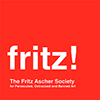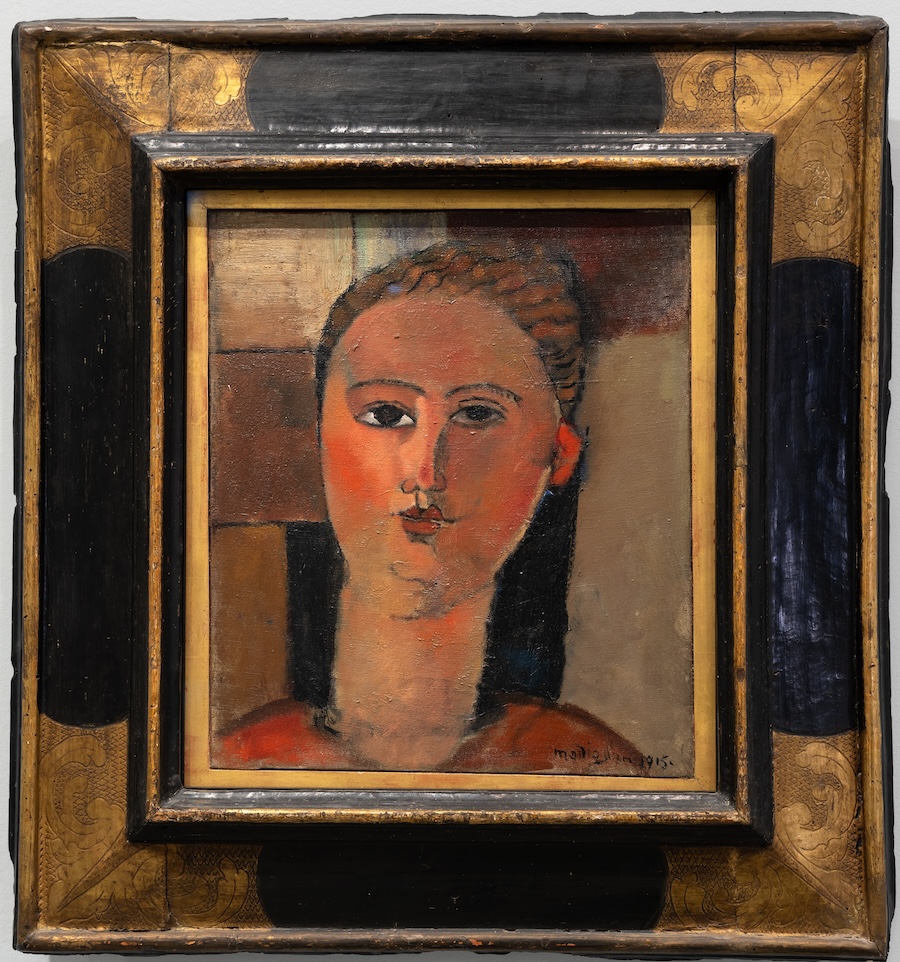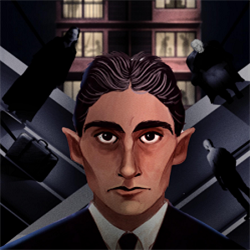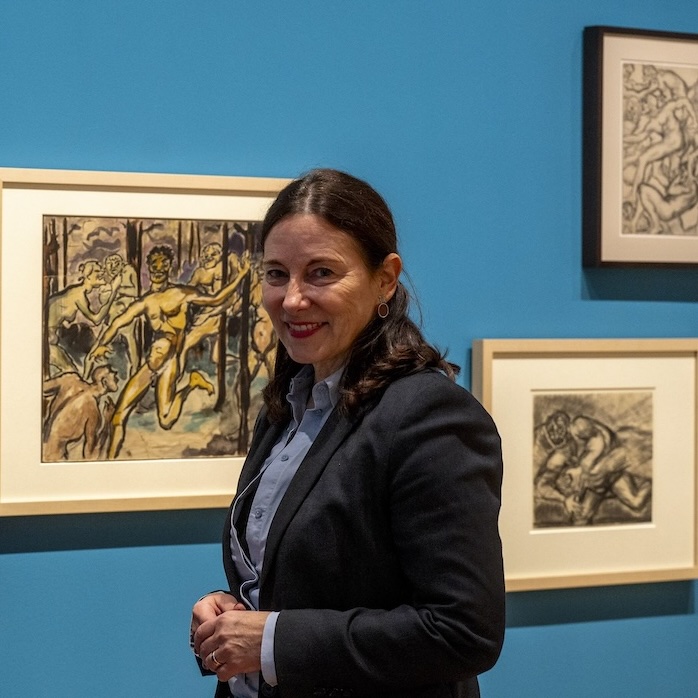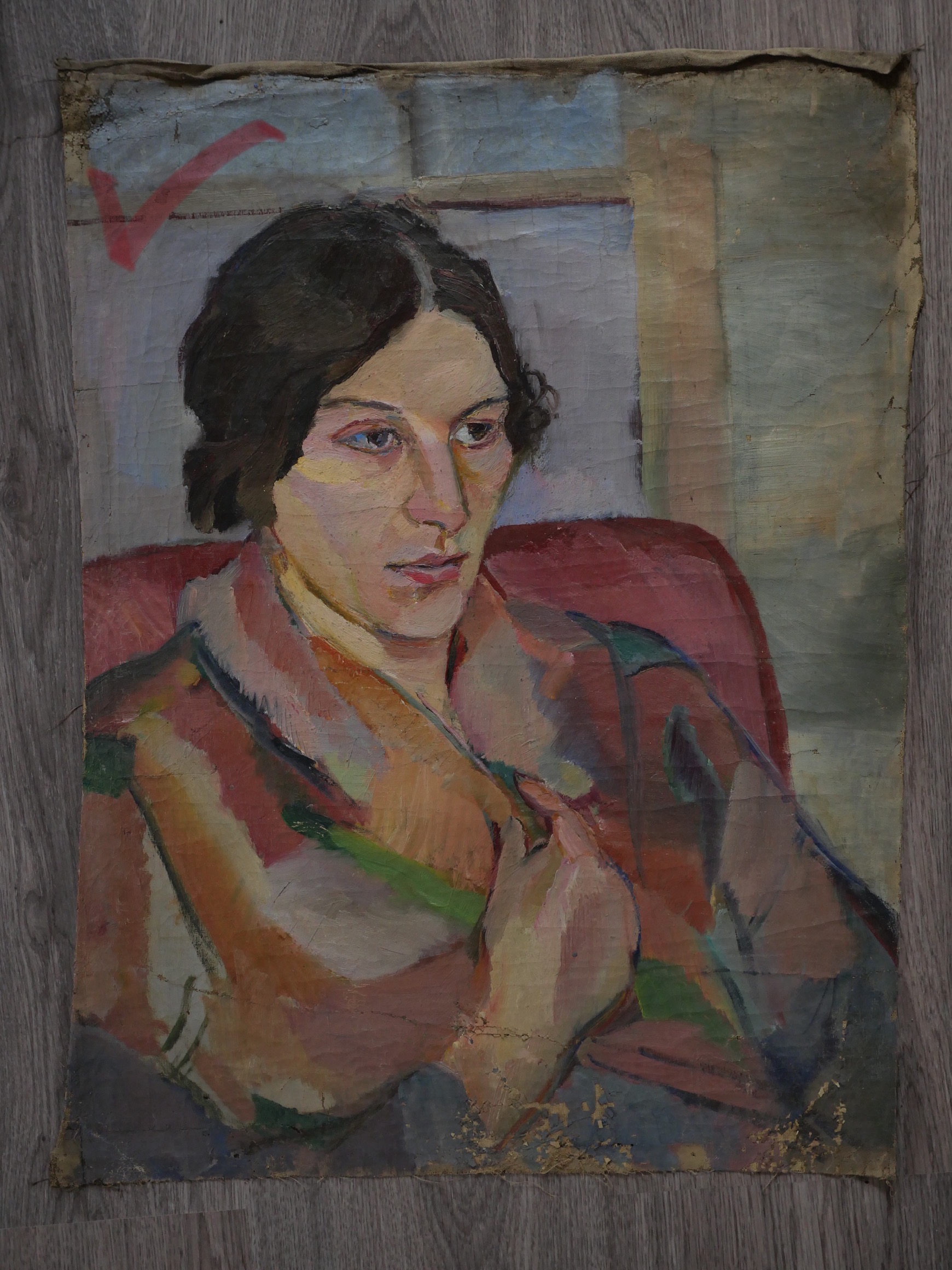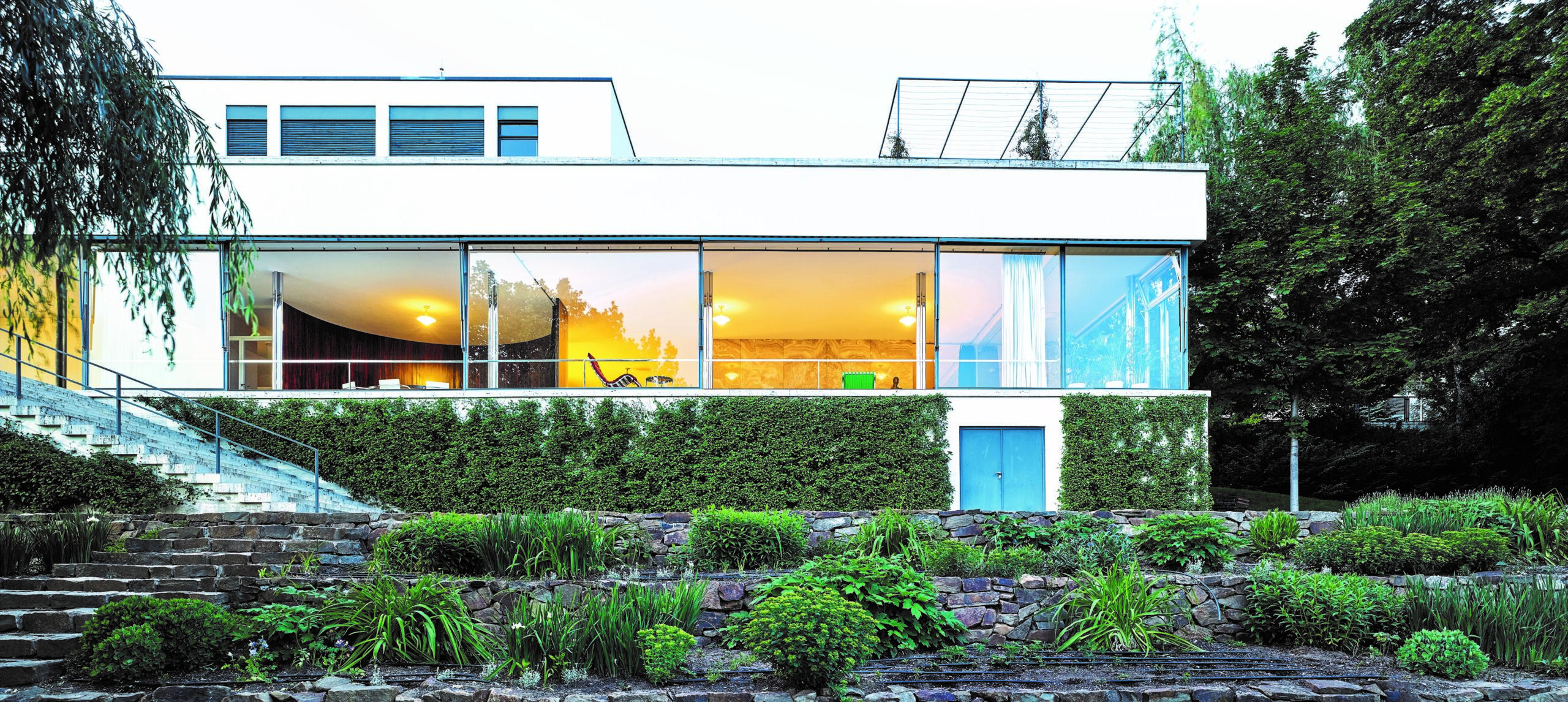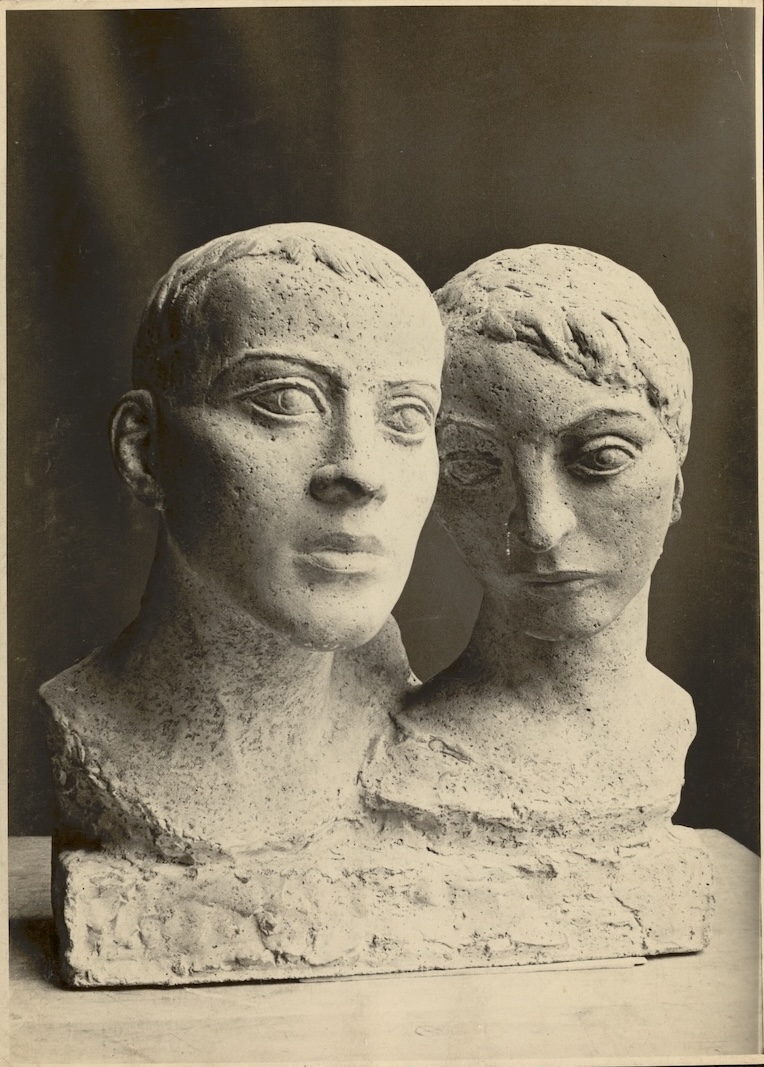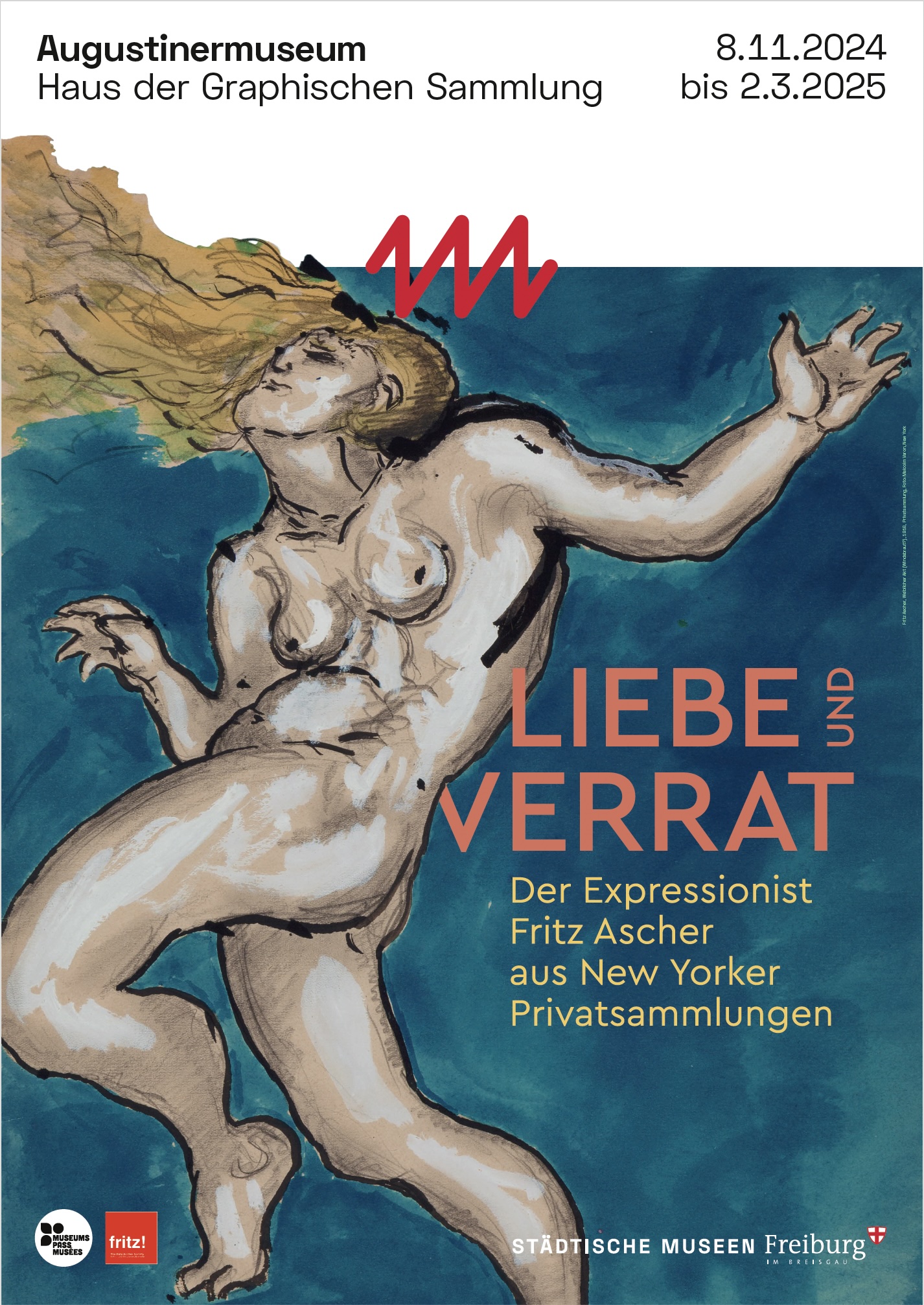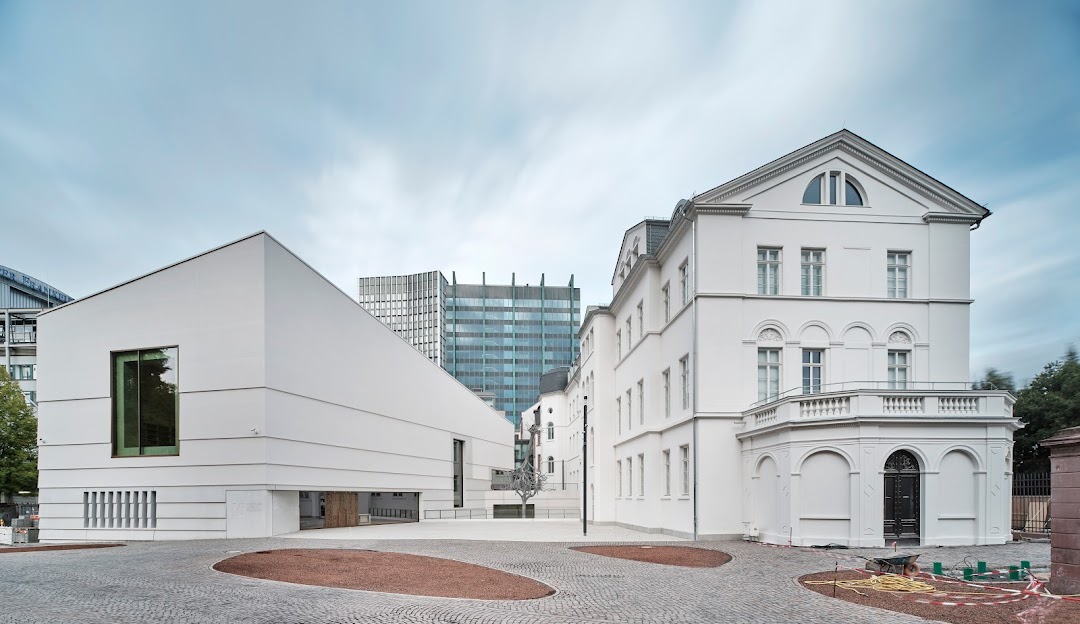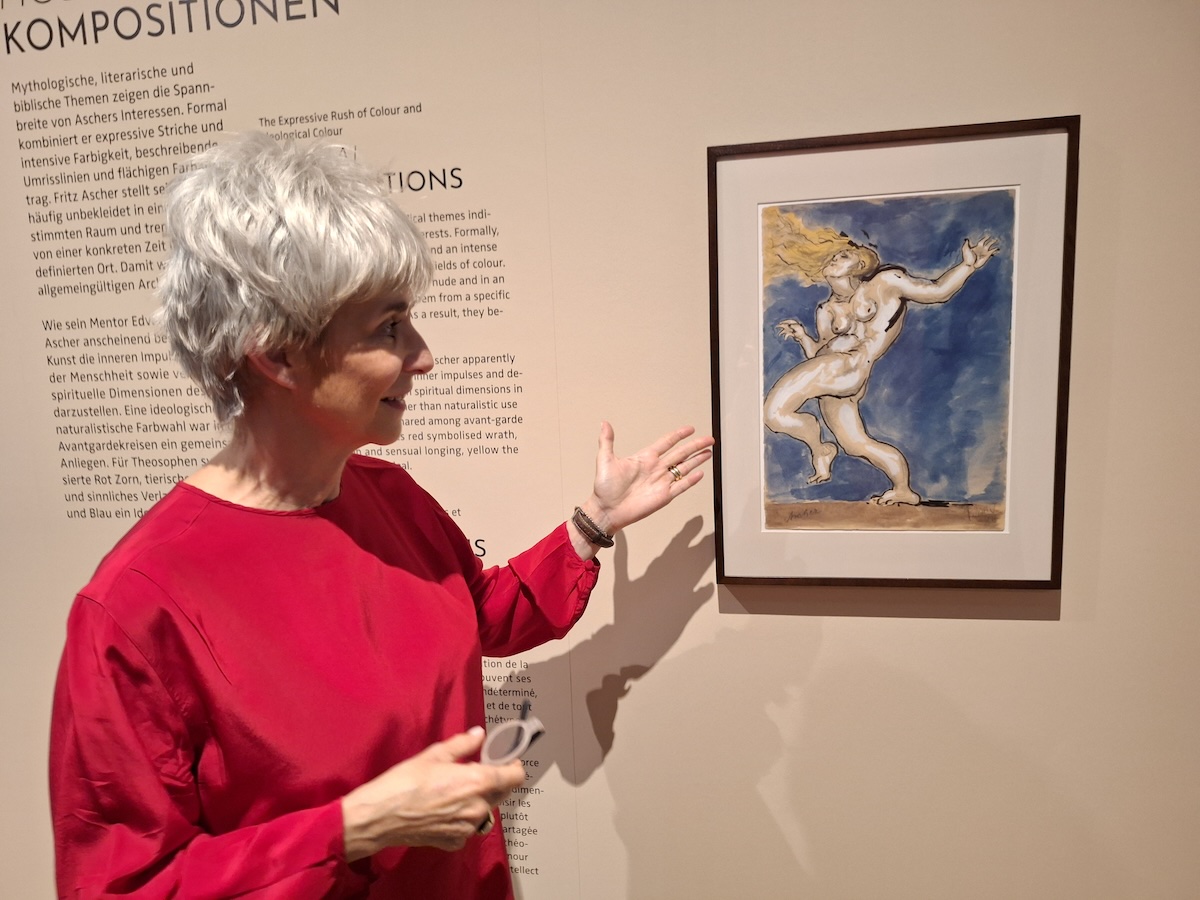Rachel Stern2025-01-09T13:35:50-05:00December 24th, 2024|Newsletter|
Dear Friends, We wish you Happy Holidays with Mayer Kirshenblatt's painting Hanukkah, in which he remembers celebrating the holiday with his family in Opatów (Apt) in the 1920s. "This is Hanukkah at home with my father, mother, and brothers. We lit the candles and sang Maoz tsur (Rock of Ages). I painted a few notes to indicate that we were singing. It was a special day for us because we were let out of school early. Father gave me Hanukkah gelt, a few pennies for a present, in honor of the holiday. Mother cooked latkes, potato pancakes, which are very delicious. She grated raw potatoes, added eggs, and flour and fried the pancakes in shmalts, [...]
Rachel Stern2025-01-22T13:31:12-05:00December 22nd, 2024|Events, Lectures, Past Events|
Berthe Weill was a trailblazing art dealer who exhibited works by emerging artists in her Parisian gallery from 1901 to 1941. Even though many of them went on to become key avant-garde figures, Weill’s role has been omitted from most historical accounts of 20th-century modernism. In this presentation, Lynn Gumpert, a co-curator of the first exhibition on Weill, provides an overview of this remarkable woman. Image above: Amedeo Modigliani, Fille rousse (Girl with red hair), c. 1915. Oil on canvas, 16 x 14 3/8 in. (40.5 x 36.5 cm). Musée de l’Orangerie, Paris. Jean Walter and Paul Guillame Collection, 1960.46 © Photo: Musée de l’Orangerie / Sophie Crépy Passionate and outspoken, Weill was the [...]
Rachel Stern2024-12-09T17:13:32-05:00December 9th, 2024|Events, Lectures|
Screening followed by Q+A with director Eliran Peled, writer Daphne Merkin, and author Benjamin Balint. Film and screening offered in partnership with the New York Jewish Week. Co-sponsored by Fritz Ascher Society for Persecuted, Ostracized and Banned Art. Upon his death in 1924, the great Czech-Austrian novelist Franz Kafka left behind a rich collection of unpublished manuscripts, with instructions to his friend Max Brod to burn them all. Thanks to Brod’s failure to fulfill Kafka’s wishes, the world has come to know one of the great writers of the 20th century. Now, 100 years after his death, the film “Kafka’s Last Trial” tells the story of this altruistic betrayal and the multi-generational effort to preserve Kafka’s literary legacy. Based on [...]
Rachel Stern2024-12-18T05:55:27-05:00December 4th, 2024|Events, Lectures, Past Events|
Jutta Götzmann, exhibition curator of "Love and Betrayal," presents the artist Fritz Ascher (1893-1970) during a tour. In addition to early charcoal, graphite and ink drawings, colorful gouaches are fascinating. Poems that are considered his "unpainted pictures" and were created in secret during the National Socialist era complement the exhibition. BUY TICKETS HERE The Fritz Ascher Society is a not-for-profit 501(c)3 organization. Your donation is fully tax deductible. YOUR SUPPORT MAKES OUR WORK POSSIBLE. THANK YOU. DONATE HERE
Rachel Stern2024-12-12T19:30:39-05:00November 26th, 2024|Newsletter|
Dear Friends, What a whirlwind of a month this was, with the opening of the important new Fritz Ascher exhibition, "Love and Betrayal - The Expressionist Fritz Ascher from New York Private Collections" at the House of the Graphic Collection, Augustinermuseum in Freiburg im Breisgau (Germany). This is the first exhibition that focusses on works on paper created by Fritz Ascher before 1933. In this most immediate and intimate medium, we discover the cheerful and thoughtful artist who was part of the avant-garde in what was then the most exciting cultural city in the world and who spontaneously recorded his thoughts, ideas and experiences on paper, or worked on pictorial themes or compositions. The exhibition is on view [...]
Rachel Stern2024-12-18T14:18:11-05:00November 24th, 2024|Events, Lectures, Past Events|
In this book talk, Michael Lambek follows the intertwined history of Mies van der Rohe’s iconic Villa Tugendhat and the family who inhabited it from 1930-1938. Part memoir, part social history, the book traces the family from its origins in a Jewish ghetto to the present day, focussing on the author’s maternal grandmother, Grete Tugendhat who commissioned and championed the house, which is now a World Heritage Site in Brno, Czechia. Image above: Ludwig Mies van der Rohe, Villa Tugendhat, Brno (Czechia), photo David Zidlicky The Villa Tugendhat, designed by Mies van der Rohe in 1929, is an icon of architectural modernism in Brno, Czechia. It was also a family home. [...]
Rachel Stern2025-11-21T11:01:33-05:00November 22nd, 2024|Exhibitions, Past Exhibitions|
Survival and Intimations of Immortality: The Art of Alice Lok Cahana, Rabbi Ronnie Cahana, and Kitra Cahana is a unique and powerful exhibition that explores the role of art and creativity, bringing the past into the present by focusing on three generations of artists from the same family. Alice Lok Cahana (1929-2017) was a Holocaust survivor who pledged she would become an artist if she survived the war. Rabbi Ronnie Cahana, Alice’s oldest son, is a poet and survivor of a major stroke. Kitra Cahana, Ronnie’s daughter, is a filmmaker and photographer. This exhibition reveals how the tragedy of the Holocaust impacted multiple generations of a family and how each member transformed the destructive trauma of the Shoah into [...]
Rachel Stern2025-01-09T14:27:52-05:00November 21st, 2024|Events, Lectures, Past Events|
Born in 1894 in Frankfurt into an Austrian and German Jewish family, Fred Kormis’ life and career were shaped and disrupted by some of the most significant events of the twentieth century. Kormis saw action and was wounded in the First World War as part of the Austrian army, before being held for four years as a prisoner of war in Siberia. Image above: Fred Kormis, Two Heads, c. 1930s © Wiener Holocaust Library Collections He worked as an artist during the politically and culturally tumultuous Weimar period, and during the Nazi era revealed himself to be Jewish, a decision that led to the removal of his art from galleries. Kormis and his wife Rachel Sender [...]
Rachel Stern2024-12-05T06:58:15-05:00November 19th, 2024|Events, Lectures, Past Events|
While workmen were demolishing a house on Prague’s outskirts in July 2018 they were astonished to be deluged by works of art falling from a ceiling. Nobody knew the works had been hidden there. The art turned out to be that of Gertrud Kauders who had hidden them in the house of a friend before being deported to Theresienstadt and then to Majdanek where she was murdered on arrival in May 1942. Kauders was a serious and inventive artist, quite well known in Prague’s art world of the time. She worked in oils, pencil, crayon, watercolour and gouache. Now her work is held by museums around the world. Image above: Gertrud Kauders © Kauders Family Estate [...]
Rachel Stern2024-12-12T19:00:08-05:00October 29th, 2024|Newsletter|
Dear Friends, Breathtaking foliage, crisp weather and the change of clocks are the messengers of fall - a fall that brings an important election in the United States - please vote, everyone! - and the opening of the Fritz Ascher exhibition in Freiburg im Breisgau in Germany. If you can, please join me there! And don't miss the online presentation of this very little known woman artist: WEDNESDAY, NOVEMBER 20 ONLINE FELKA PLATEK - ARTIST AND COMPANION OF THE PAINTER FELIX NUSSBAUM Presentation by Anne Sibylle Schwetter REGISTRATION FOR ONLINE EVENT Felka Platek, Self-portrait in front of an open window, around 1940. Gouache on drawing paper, 65 x 49.7 cm. Felix-Nussbaum-Haus [...]
Rachel Stern2024-11-24T14:39:31-05:00October 28th, 2024|Events, Lectures, Past Events|
Der Maler, Grafiker und Dichter Fritz Ascher (1893-1970) wurde bereits als 16-Jähriger von Max Liebermann an die Akademie in Königsberg empfohlen. Ab 1913 gehörte er zu den gefragten Malern in Berlin. Er war ein genauer Beobachter seiner Zeit; die Urkatastrophe des Ersten Weltkriegs und die revolutionären Unruhen in Berlin führten ihn zu christlichen und mystischen Themen, die er radikal neu interpretierte. Nach 1933 erhielt Ascher als Jude Berufsverbot. Während der Pogrome am 9./10. November 1938 wurde er verhaftet und im Konzentrationslager Sachsenhausen und im Potsdamer Gestapo-Gefängnis interniert. Die Schoa überlebte er ab 1942 versteckt in einem Keller in Berlin-Grunewald. Während dieser einsamen Jahre verfasste er Gedichte. Als Künstler fand Ascher nach 1945 seinen ganz eigenen Stil. Angeregt vom nahe [...]
Rachel Stern2024-11-24T14:40:53-05:00October 22nd, 2024|Events, Lectures, Past Events|
Der spätexpressionistische Künstler Fritz Ascher (1893-1970) überlebte zwei Weltkriege und die Verfolgung durch das nationalsozialistische Regime. Als aufmerksamer Beobachter der Schrecken des Ersten Weltkriegs und der revolutionären Unruhen wandte er sich christlich-spirituellen Themen zu, die er radikal neu interpretierte. In intimen Zeichnungen beschäftigte er sich ab 1916 mit dem Thema Liebe und Verrat, sowohl in seiner Auseinandersetzung mit dem Kreuzigungsthema als auch mit der Figur des Bajazzo in der tragikomischen Oper „I Pagliacci“. Kurzvortrag und Führung von Rachel Stern zeigen den Künstler in seinem sozialen und politischen Umfeld. Image above: Fritz Ascher, Im Wald, um 1919. Weisse Gouache und schwarze Tusche über Aquarell und Bleistift auf Papier, 34 x 32,2 cm © Bianca Stock The late expressionist [...]
